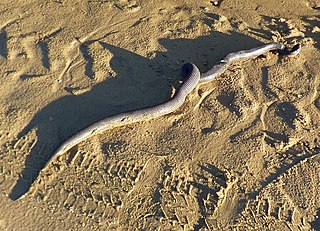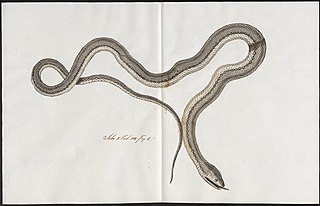
Vital Brazil Mineiro da Campanha, known as Vital Brazil, was a Brazilian physician, biomedical scientist and immunologist, known for the discovery of the polyvalent anti-ophidic serum used to treat bites of venomous snakes of the Crotalus, Bothrops and Elaps genera. He went on to be also the first to develop anti-scorpion and anti-spider serums. He was the founder of the Butantan Institute, a research center located in São Paulo, which was the first in the world dedicated exclusively to basic and applied toxicology, the science of venomous animals.

Clelia is a genus of snakes, one of three genera with species with the common name mussurana or musurana It is a genus of large snakes in the family Colubridae. The genus is endemic to Central America and South America, and species of Clelia are found from southern Mexico to Brazil. They specialize in ophiophagy, i.e., they attack and eat other snakes. Currently seven species are recognized as being valid. They have other popular names in various countries, such as zopilota in Central America and cribo on some Caribbean islands.

Bothrops alternatus is a highly venomous pit viper species found in South America. Within its range, it is an important cause of snakebite. The specific name, alternatus, which is Latin for "alternating", is apparently a reference to the staggered markings along the body. No subspecies are currently recognized.
Philodryas is a genus of colubrid snakes endemic to South America, commonly called green snakes.

Corallus cropanii, or Cropani's tree boa, is a species of boa, a snake in the family Boidae. The species is endemic to the state of São Paulo, Brazil. Like all boas, it is not venomous. No subspecies are currently recognized. Until 2017, no specimen of this snake had been seen alive since 1953 and only five dead specimens had been collected since then, but in late January 2017, an adult female Cropan's tree boa measuring 1.7 m was captured by locals in Ribeira who brought it to herpetologists from the Instituto Butantan and the Museum of Zoology of the University of São Paulo, who radio-tagged and released the animal to learn more about the species' behavior.

Bothrops jararacussu, commonly known in English as the jararacussu, is a highly venomous pit viper species endemic to South America. It is one of the most dreaded snakes in South America and can grow up to 2.2 metres (7.2 ft).

The military ground snake is a species of snake in the family Colubridae. The species is endemic to South America.

Amphisbaena mertensii, also known as the Mertens' worm lizard or Mertens's worm lizard, is a species of worm lizard in the family Amphisbaenidae. The species is endemic to South America.

Liotyphlops ternetzii beui is a species of nonvenomous snake in the family Anomalepididae. The species is native to northeastern Argentina, eastern Paraguay, and central-western, southeastern, and southern Brazil; the Reptile Database restricts its range to Brazil. It is locally common in Brazil. It is sometimes known as the pale-headed blindsnake.
Liotyphlops ternetzii is a species of snake in the family Anomalepididae. The species is endemic to South America.

Oxyrhopus guibei is a species of snake in the family Colubridae. The species is endemic to South America. It is often called the false coral snake, but this common name can refer to any of a long list of other species, genera, and even entire families of snakes. Many nonvenomous snakes have evolved coloration that mimics that of venomous true coral snakes, a trait which helps them avoid predation.

Clelia clelia, commonly known as the black mussurana or windward cribo, is a species of snake in the family Colubridae. The species is native to the New World.
Mussurana bicolor, the two-colored mussurana, is a species of snake in the family Colubridae. The species is native to southern South America.
Simophis is a genus of snake in the family Colubridae that contains the sole species Simophis rhinostoma. It is commonly known as the São Paulo false coral snake.

Phalotris is a genus of snakes of the subfamily Dipsadinae. All species of the genus Phalotris are found in South America. The specific name, mertensi, is in honor of German herpetologist Robert Mertens. The specific name, normanscotti, is in honor of Norman Scott, Jr., in recognition of his contribution to the knowledge of the herpetofauna of Paraguay.
Rhachidelus is a genus of snake in the subfamily Dipsadinae of the family Colubridae. The genus is endemic to South America.

Atractus pantostictus is a species of snake in the family Colubridae.

Boiruna maculata, the Mussurana, is a species of snake in the family Colubridae. The species can be found in Bolivia, Brazil, Argentina, Uruguay, and Paraguay.
Mussurana quimi is a species of snake in the family Colubridae. The species is native to Brazil, Argentina, and Paraguay.

Pseudoeryx plicatilis, the South American pond snake, is a species of snake of the family Colubridae.












